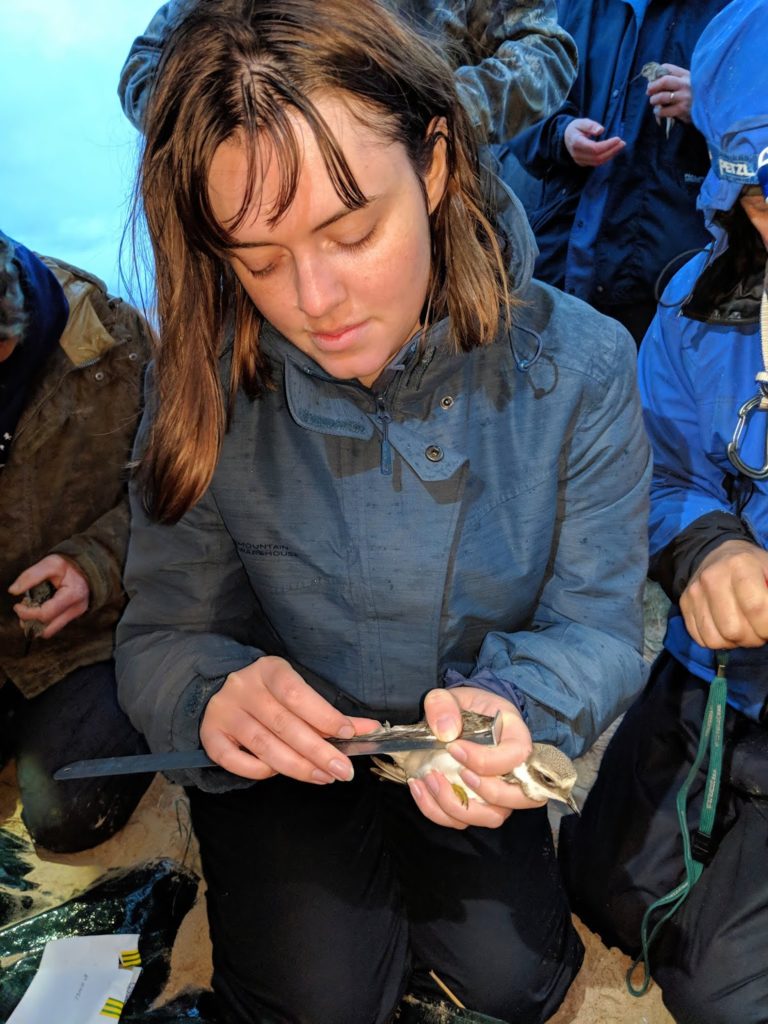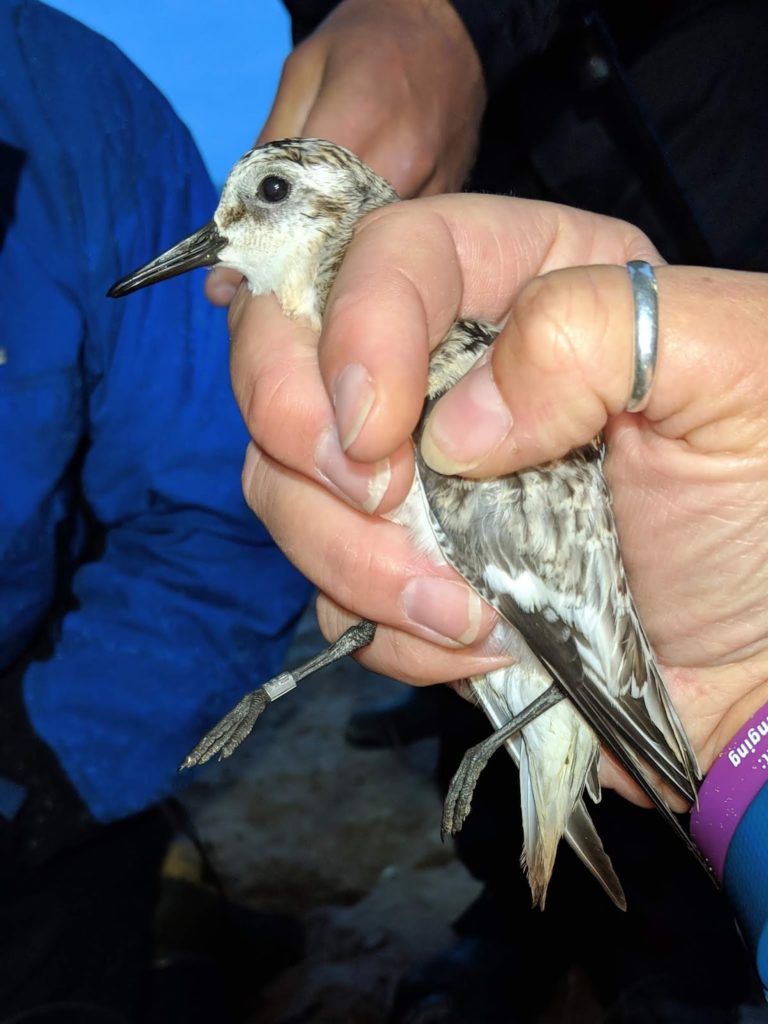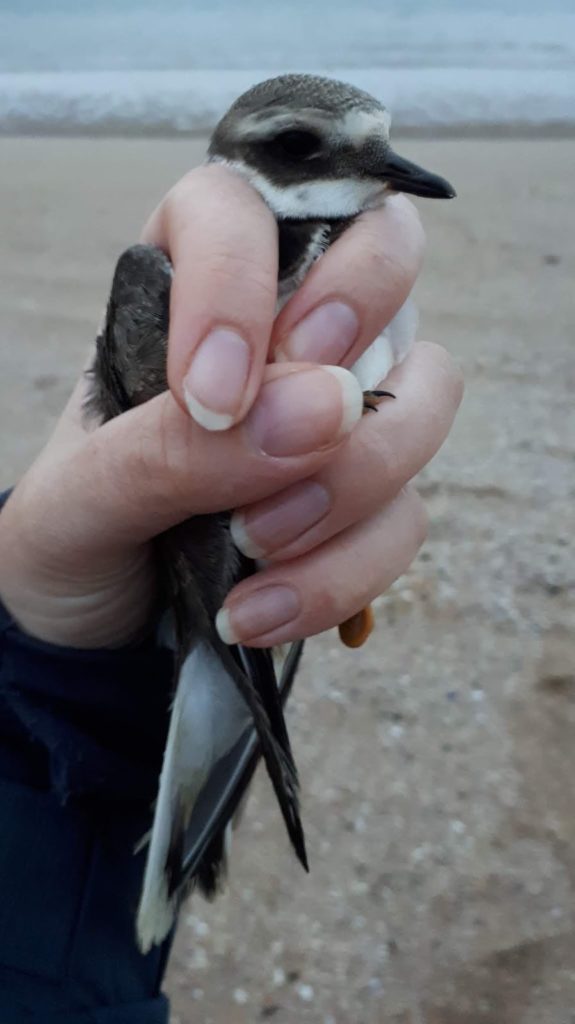The 2018 Welsh Ringing Course was held on the Gower Peninsula, South Wales, between Friday 7 and Monday 10 September 2018.
The course was led by Kelvin Jones, the Welsh Development Officer for the British Trust for Ornithology (BTO) and a ringing trainer, the independent trainer was Martin Hughes (from Northumberland), and other trainers present were Tony Cross (mid-Wales Ringing Group). Gwynedd Roberts, Justin Walker (BTO), Heather Coats and Owain Gabb (Gower Ringing Group). There were 10 participants whose aspirations were either to be appraised with regard to a potential permit upgrade, or to achieve further experience.
The itinerary included evening swallow and wagtail roost sessions and daytime mist netting at Oxwich Marsh, dazzling waders at Whiteford Burrows, and training sessions on whoosh netting, erection and taking down of mist nets at Parkmill.
A total of 445 birds of 33 species were captured. The breakdown was as follows:
|
Species
Name
|
Ringed
|
Recaptured
|
Total
|
|
Blackbird
|
3
|
1
|
4
|
|
Blackcap
|
7
|
|
7
|
|
Blue Tit
|
18
|
25
|
43
|
|
Bullfinch
|
|
3
|
3
|
|
Cetti’s
Warbler
|
1
|
2
|
3
|
|
Chaffinch
|
3
|
6
|
9
|
|
Chiffchaff
|
7
|
|
7
|
|
Coal Tit
|
1
|
|
1
|
|
Dunlin
|
56
|
|
56
|
|
Dunnock
|
4
|
27
|
31
|
|
Goldfinch
|
43
|
16
|
59
|
|
Great
Spotted Woodpecker
|
|
8
|
8
|
|
Great
Tit
|
1
|
32
|
33
|
|
Green
Woodpecker
|
1
|
|
1
|
|
Greenfinch
|
21
|
8
|
29
|
|
Grey
Wagtail
|
1
|
|
1
|
|
Nuthatch
|
1
|
|
1
|
|
Pied/White
Wagtail
|
9
|
|
9
|
|
Reed
Bunting
|
4
|
4
|
8
|
|
Reed
Warbler
|
8
|
5
|
13
|
|
Ringed
Plover
|
6
|
|
6
|
|
Robin
|
4
|
6
|
10
|
|
Sanderling
|
1
|
|
1
|
|
Sedge
Warbler
|
12
|
1
|
13
|
|
Siskin
|
9
|
10
|
19
|
|
Song
Thrush
|
1
|
|
1
|
|
Sparrowhawk
|
|
1
|
1
|
|
Stonechat
|
1
|
|
1
|
|
Swallow
|
54
|
|
54
|
|
Turnstone
|
2
|
|
2
|
|
Whitethroat
|
1
|
1
|
2
|
|
Willow
Warbler
|
5
|
|
5
|
|
Wren
|
4
|
|
4
|
|
Total
|
290
|
155
|
445
|
Despite a feeling that the total was well down on previous years (due to weather), this was not in fact the case. In 2017 we captured 451 birds of 33 species, in 2016 411 birds of 32 species, and in 2015 409 birds of 31 species.
Daytime Mist Netting
The weather during the course made mist netting difficult. A front brought in strong south-westerly winds and frequent light to heavy rain, some of which was prolonged. It also seemingly bottled up migrants, with very few hirundines apparent and migrant warblers generally scarce.
We only managed one session (on the Monday morning) with all nets open (including those in reed bed, fen and bracken / ruderal vegetation). On the Saturday and Sunday we were limited to putting nets in areas of sheltered scrub.
The highlights included a nuthatch, a second calendar year male sparrowhawk, a stonechat, a few Cetti’s warblers and a great spotted woodpecker with a mutation that had resulted in the growth of a fully formed feather (similar to a tail feather) in the middle of its back (see photo below).
Roost Sessions
Roost sessions at Oxwich involved the deployment of five eighteen metre nets in an area of reebed near the South Pond, and a line of nets across a bund through the marsh. We also tried for grey wagtails in a triangle of nets normally used for pipits. Audio was used to lure the respective target species into the netting areas.
The catches of swallows were very small, and sand martins were conspicuous by their absence. The wagtail roost sessions were similarly disappointing (we captured 40 pied / white wagtails on a single night during the 2017 ringing course) but only managed 9 birds over the course of two sessions this year.
There were some silver linings, however; a juvenile male green woodpecker was captured commuting across the reed bed towards woodland on the landward side of the site, and a grey wagtail was the first of the year. Passage of grey wagtails (west) over the site was noted on the final morning.
A nightjar was seen in flight at the end of the first swallow session, and on the road early on the Monday morning. Unfortunately our attempts to capture it were unsuccessful.
Wader Dazzling
Dazzling sessions (led by Tony Cross) were held at Whiteford Burrows at the mouth of the Burry Inlet. High tide on Saturday 8 September was 05:30, giving us a window of around 1.5 hours (mainly on the rising tide) for dazzling. A second session was conducted the following evening; this allowed training on dazzling techniques for a few people who had expressed a particular interest.
Mixed roosts of various small waders are generally present on the upper shore of Berges Island, Whiteford. We were most successful in capturing dunlin, with 56 birds ringed, but also captured small numbers of ringed plover (6), turnstone (2) and a sanderling.
The technique was new to most people, as were some of the measurements taken (bill to skull, total head and tarsus length).
Other Activities
Feedback from previous years was that a session on putting up and taking down of mist nets would be useful, so participants got some practice in this in the grounds of our lodgings at Parkmill. A session showing how to set up and fire a whoosh net also took place.
We tried whoosh netting and spring trapping on the storm beach at Overton on the Saturday evening of the course. This proved unsuccessful due to the amount of alternative food (a fly hatch and sandhoppers) present, and the reluctance of the pied wagtails, rock pipits and stonechats present to move into the catching area. There was a mixed gull flock close in; five species were present including Mediterranean gulls and a young kittiwake.
Due to weather making the itinerary particular hectic, people used downtime for relaxing and catching up on sleep. As a result, we did not run a training / QA session on Demon, which will be part of the course in future years.
Logistics
For practical purposes the participants were split into two groups, with two separate canvas gazebos erected (allowing a degree of shelter from the wind and discrete areas in which to process the birds). The teams worked closely enough to each other to allow communication with regard to net rounds and ensure new species for participants could be shared out.
Accommodation was in the Guide Centre at Parkmill, approximately 4 miles from the ringing site. Excellent evening meals were provided at the centre by Phyllis Jamieson. Some of the team went to the Gower Inn (next door) following packing up in the evenings, and the bakery at the nearby Gower Heritage Centre for organic bread and cake.
Feedback on the course from participants was very positive. Thanks are due to all involved in the setting up and delivery of the course, but particularly to the helpers (Wayne Morris, Keith Vaughton, Richard Dann, Joanne Conway, Alex McCubbin, Sarah Davies, Martin Georgiev, Emma Cole and Lynn Watts) whose hard work, friendliness and willingness to do anything needed contributed to a very good atmosphere and hopefully helped participants to relax.
Thanks are also due to Nick Edwards of Natural Resources Wales for continued permission to ring at Oxwich and at Whiteford, and to the Gower Society for their grant funding of ringing on the marsh.
Photographs are below.
Owain Gabb
13/09/2018
 |
L-R [REAR]: Colin Gunnell, Mike Baron, Alison Rees, Martin Hughes, Andrew Hughes, Paul Roughley, Trevor Fletcher, Chantelle Barry, Dafydd Roberts, Justin Walker, Kelvin Jones, Heather Coats, Gwyn Roberts, Owain Gabb, Tony Cross, Sarah Davies.
L-R (FRONT): Keith Vaughton, Richard Dann, Juan Verhelst, Ivan de la Hera. |
 |
| Green woodpecker (Joanne Conway) |
 |
| Processing a ringed plover (Justin Walker) |
 |
| Sanderling (Justin Walker) |
 |
| A genetic mutation in a great spotted woodpecker (Justin Walker) |
 |
| Ringed plover (Chantelle Barry) |
 |
| Whoosh net session at Parkmill (Chantelle Barry) |
 |
| Discussing sexing the young green woodpecker (Kelvin Jones) |
 |
| Nuthatch (Richard Dann) |








